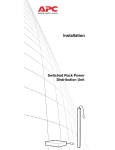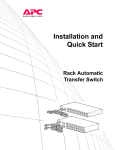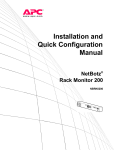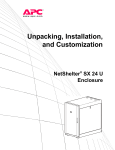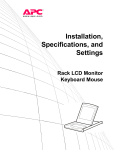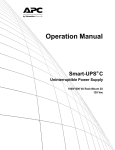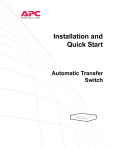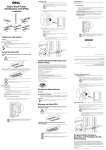Download APC Rack PDU, Metered, Zero U,12.5kW,208V
Transcript
Installation Metered Rack Power Distribution Unit This manual is available in English on the enclosed CD. Dieses Handbuch ist in Deutsch auf der beiliegenden CD-ROM verfügbar. Este manual está disponible en español en el CD-ROM adjunto. Ce manuel est disponible en français sur le CD-ROM ci-inclus. Questo manuale è disponibile in italiano nel CD-ROM allegato. 本マニュアルの日本語版は同梱の CD-ROM からご覧になれ ます。 Instrukcja Obsługi w jezyku polskim jest dostepna na CD. Данное руководство на русском языке имеется на прилагаемом компакт-диске. O manual em Português está disponível no CD-ROM em anexo. Bu kullanim kilavuzunun Türkçe'sä, äläxäkte gönderälen CD äçeräsände mevcuttur. 您可以从包含的 CD 上获得本手册的中文版本。 Contents Preliminary Information . . . . . . . . . . . . . . . . . . .1 Features . . . . . . . . . . . . . . . . . . . . . . . . . . . . . 1 Display interface . . . . . . . . . . . . . . . . . . . . . . 1 Receiving inspection . . . . . . . . . . . . . . . . . . . 1 Please recycle . . . . . . . . . . . . . . . . . . . . . . . . 1 Install the PDU . . . . . . . . . . . . . . . . . . . . . . . . . .2 Attach the cord retention trays . . . . . . . . . . . 2 Attach cords to the tray . . . . . . . . . . . . . . . . . 2 Mounting options . . . . . . . . . . . . . . . . . . . . . . 3 Toolless mounting . . . . . . . . . . . . . . . . . . . . . 3 Bracket mounting . . . . . . . . . . . . . . . . . . . . . . 4 Display Interface Operation . . . . . . . . . . . . . . .7 Quick Configuration. . . . . . . . . . . . . . . . . . . . . .8 Overview . . . . . . . . . . . . . . . . . . . . . . . . . . . . . 8 TCP/IP configuration methods . . . . . . . . . . . 8 APC Device IP Configuration Wizard . . . . . . 9 BOOTP & DHCP configuration . . . . . . . . . . . 9 Local access to the control console . . . . . 12 Remote access to the control console . . . 13 Control console . . . . . . . . . . . . . . . . . . . . . . 14 Access a Configured PDU . . . . . . . . . . . . . . . .15 Overview . . . . . . . . . . . . . . . . . . . . . . . . . . . . 15 Web interface . . . . . . . . . . . . . . . . . . . . . . . . 15 Telnet and SSH . . . . . . . . . . . . . . . . . . . . . . . 16 SNMP . . . . . . . . . . . . . . . . . . . . . . . . . . . . . . . 16 FTP and SCP . . . . . . . . . . . . . . . . . . . . . . . . . 17 Managing the security of your system . . . . 17 How to Recover From a Lost Password . . . .18 How to Update Firmware . . . . . . . . . . . . . . . . .19 Warranty and Service . . . . . . . . . . . . . . . . . . .20 Limited warranty . . . . . . . . . . . . . . . . . . . . . 20 Warranty limitations . . . . . . . . . . . . . . . . . . . 20 Obtaining service . . . . . . . . . . . . . . . . . . . . . 20 Life-Support Policy . . . . . . . . . . . . . . . . . . . . .22 General policy . . . . . . . . . . . . . . . . . . . . . . . 22 Examples of life-support devices . . . . . . . . 22 Metered Rack Power Distribution Unit i Preliminary Information Features This booklet provides information on installing and operating Metered Rack Power Distribution Units (PDUs). Each PDU has a sensor that measures the current being used by the PDU and its attached devices, and can be monitored through the Web, Telnet, SSH, SNMP, or InfraStruXure Manager interfaces. Display interface The display interface on the PDU shows the aggregate current being used by the PDU and its attached devices. An alarm occurs if the aggregate current is above the high threshold value or below the low threshold value that you configure. Receiving inspection Inspect the package and contents for shipping damage, and make sure that all parts were sent. Report any damage immediately to the shipping agent, and report missing contents, damage, or other problems immediately to APC or your APC reseller. Please recycle The shipping materials are recyclable. Please save them for later use, or dispose of them appropriately. Metered Rack Power Distribution Unit 1 Install the PDU Attach the cord retention trays pdu0123b Attach the cord retention trays to the PDU, using four flat-head screws (provided) per tray. Attach cords to the tray pdu0127b Attach a cord to the tray by looping the cord and securing it to the tray, using a wire tie (provided). Note Note 2 Each cord must be secured to the tray so that you can unplug it from the PDU without removing the wire tie. When installing the PDUs, ensure that the power cord plug is accessible and that the PDU is connected to a grounded outlet. Metered Rack Power Distribution Unit Mounting options You can install the PDU in one of two ways: using toolless mounting pegs (provided) or mounting brackets (provided). The 1-U and 2-U horizontal PDUs must be mounted using the horizontal mounting brackets. Vertical mounting. • To install the PDU using the toolless mounting method, install it in the rear of the NetShelter® VX or SX Enclosure, in the cable channel directly behind the rear vertical mounting rails. • To install the PDU using the mounting brackets, install it on a vertical mounting rail on your rack or enclosure. Horizontal mounting. To install the PDU using the horizontal mounting brackets, install the brackets on the PDU and then attach the PDU to the rack using cage nuts (provided with your enclosure). Toolless mounting 1. Slide both mounting pegs into the holes located in the channel in the rear panel of the enclosure. pdu0119b 2. Snap the PDU into place by pushing it downward until it locks into position. You can mount two PDUs on one side of the enclosure by using the toolless mounting method. Note Metered Rack Power Distribution Unit 3 Bracket mounting Vertical mounting. To mount the PDU vertically in a NetShelter or any standard EIA-310 rack or enclosure: 1. Attach the vertical-mounting brackets to the PDU. Use only the supplied screws. pdu0344a Caution pdu0190b 2. Install the PDU on a vertical mounting rail in your rack or enclosure using the screws and cage nuts supplied with your enclosure. 4 Metered Rack Power Distribution Unit Horizontal mounting. You can mount the PDU in a 19-inch NetShelter or other EIA-310-D standard 19-inch rack: 1. Choose a mounting position for the PDU with either the display or the rear facing out of the enclosure. pdu0352a 2. Attach the mounting brackets to the PDU, using the flat-head screws (provided). 3. Choose a location for the unit: Note The unit occupies one U-space. A notched hole (or a number, on newer enclosures) on the enclosure’s vertical rail indicates the middle of a U-space. a. Insert cage nuts (provided with the enclosure) above and below a notched hole on each vertical mounting rail in your chosen location. pdu0353a b. Align the mounting holes of the brackets with the installed cage nuts. Insert and tighten screws. Metered Rack Power Distribution Unit 5 pdu0369a Recessed horizontal mounting. You can mount the PDU in a recessed configuration by attaching the brackets as shown in the following illustration of the PDU. 6 Metered Rack Power Distribution Unit Display Interface Operation B1 B2 — TOTAL — Amps Press to select bank. Press and hold to invert display. Link - Rx/Tx 10 /100 Amps Status Reset Metered Rack PDU Serial Port pdu0291a - OK - Warning - Overload Bank/phase indicator LEDs: • Indicate the bank/phase corresponding to the current listed in the digital display. • Indicate normal (green), warning (yellow), or alarm (red) condition. NOTE: If all indicator LEDs are lit, the Rack PDU is in use at its maximum capacity. Control button: • Press to change the bank/phase of the current displayed on the digital display. • Press and hold for five seconds to view the orientation of the display; hold for an additional five seconds to change the orientation. Ethernet port: Connects the PDU to your network, using a CAT5 network cable. Status LED: Indicates the status of the Ethernet LAN connection and the state of the PDU. • Off–The PDU has no power. • Solid green–The PDU has valid TCP/IP settings. • Flashing green–The PDU does not have valid TCP/ IP settings. • Solid orange–A hardware failure has been detected in the PDU. Contact Customer Support at a phone number on the back cover of this manual. • Flashing orange–The PDU is making BOOTP requests. Link LED: Indicates whether there is activity on the network. Serial port: Access internal menus by connecting this port (RJ-11 modular port) to a serial port on your computer, using the supplied serial cable (part number 940-0144). Display of the current used by the PDU and attached devices: • Shows the aggregate current for the bank/phase corresponding to the Bank/Phase Indicator LED that is illuminated. • Cycles through the banks/phases in 3-second intervals. Reset switch: Resets the PDU without affecting the outlets. See “Front Panel” in the “Introduction” of the User’s Guide for more detailed display information on single-phase See also and three-phase PDUs. Metered Rack Power Distribution Unit 7 Quick Configuration Disregard the procedures in this section if you have APC InfraStruXure Manager as part of your system. See the InfraStruXure Caution Manager’s documentation for more information. Overview You must configure the following TCP/IP settings before the PDU can operate on a network: • IP address of the PDU • Subnet mask • Default gateway Note If a default gateway is unavailable, use the IP address of a computer that is located on the same subnet as the PDU and that is usually running. The PDU uses the default gateway to test the network when traffic is very light. Do not use the loopback address (127.0.0.1) as the default gateway address. It disables the PDU’s network Caution connection and requires you to reset TCP/IP settings to their defaults using a local serial login. See “Watchdog Features” in the “Introduction” of the User’s Guide for more information about the watchdog See also role of the default gateway. TCP/IP configuration methods Use one of the following methods to define the TCP/IP settings: • APC Device IP Configuration Wizard (See “APC Device IP Configuration Wizard” on page 9) • BOOTP or DHCP server (See “BOOTP & DHCP configuration” on page 9.) • Local computer (See “Local access to the control console” on page 12.) • Networked computer (See “Remote access to the control console” on page 13.) 8 Metered Rack Power Distribution Unit APC Device IP Configuration Wizard You can use the APC Device IP Configuration Wizard at a computer running Microsoft® Windows® 2000, Windows 2003, or Windows XP to configure the basic TCP/IP setting of a Rack PDU. Note Most software firewalls must be temporarily disabled for the Wizard to discover unconfigured PDUs 1. Insert the APC Metered and Switched Rack Power Distribution Units Utility CD into a computer on your network. 2. Launch the Wizard, when prompted, or, if prompted to restart the computer, access the Wizard from the Start menu after the computer has restarted. 3. Wait for the Wizard to discover the unconfigured PDU, then follow the on-screen instructions. Note If you leave the Start a Web browser when finished option enabled, you can use apc for both the user name and password to access the Metered Rack PDU through your browser. BOOTP & DHCP configuration The TCP/IP option in the Network menu, under the Administration tab of the Web interface identifies how TCP/IP settings will be defined. The possible settings are Manual, DHCP, BOOTP, and DHCP & BOOTP (the default setting). The DHCP & BOOTP setting assumes that a properly configured DHCP or BOOTP server is available to provide TCP/IP settings to the PDU. If these servers are unavailable, see “APC Device IP Configuration Wizard” on this page, “Local access to the control console” on page 12, or “Remote access to the control console” on page 13 to configure the TCP/IP settings. With TCP/IP configuration set to DHCP & BOOTP, the PDU attempts to discover a properly configured server. It first searches for a BOOTP server, and then a DHCP server. It repeats this pattern until it discovers a BOOTP or DHCP server. For more information, see “BOOTP” on page 10 or “DHCP” on page 11. Metered Rack Power Distribution Unit 9 BOOTP. You can use an RFC951-compliant BOOTP server to configure the TCP/IP settings for the PDU. If the BOOTP server is properly configured, the PDU’s default setting (DHCP & BOOTP) for TCP/IP configuration causes it to discover the BOOTP server. If a BOOTP server is unavailable, see “APC Device IP Configuration Wizard” on page 9, “Local access to the control console” on page 12, or “Remote access to the control console” on page 13 to configure TCP/IP settings. 1. Enter the PDU’s MAC and IP addresses, the subnet mask and default gateway settings, and an optional bootup file name in the BOOTPTAB file of the BOOTP server. For the MAC address, look on the back of the PDU or on the Quality Assurance slip included in the package. 2. When the PDU reboots, the BOOTP server provides it with the TCP/IP settings. If you specified a bootup file name, the PDU attempts to transfer that file from the BOOTP server using TFTP or FTP. The PDU assumes all settings specified in the bootup file. If you did not specify a bootup file name, the PDU can be configured remotely by using Telnet or by using the Web interface: user name and password are both apc, by default. To create a bootup file, see your BOOTP server documentation. See also 10 Metered Rack Power Distribution Unit DHCP. You can use a RFC2131/RFC2132compliant DHCP server to configure the TCP/IP settings for the PDU. This section summarizes the PDU communication with a DHCP server. For more detail about how a DHCP See also server is used to configure the network settings for the PDU, see “DHCP Configuration Settings” in the User’s Guide. 1. The PDU sends a DHCP request that uses the following to identify itself: Vendor Class Identifier (APC by default) Client Identifier (by default, the PDU’s MAC address) User Class Identifier (by default, the identification of the PDU’s application firmware) 2. A properly configured DHCP server responds with a DHCP offer that includes all of the settings that the PDU needs for network communication. The DHCP offer also includes the Vendor Specific Information option (DHCP option 43). By default, the PDU ignores DHCP offers that do not encapsulate the APC cookie in the Vendor Specific Information option using the following hexidecimal format: Option 43 = 01 04 31 41 50 43 where The first byte (01) is the code The second byte (04) is the length The remaining bytes (31 41 50 43) are the APC cookie See also See your DHCP server documentation to add code to the Vendor Specific Information option. You can use a local computer to disable the APC cookie requirement. To use a local computer, see “Local access to the control console” on page 12. To change the control console’s DHCP Cookie Is setting, an Advanced option in the TCP/IP menu, use Telnet or another remote accessing method. To access the control console, see “Remote access to the control console” on page 13. Metered Rack Power Distribution Unit 11 Local access to the control console You can use a local computer to connect to the PDU to access the control console. 1. Select a serial port at the local computer, and disable any service which uses that port. 2. Use the serial cable (940-0144) to connect the selected port to the serial port on the front panel of the PDU. 3. Run a terminal program (such as HyperTerminal®) and configure the selected port for 9600 bps, 8 data bits, no parity, 1 stop bit, no flow control, and save the changes. 4. Press ENTER to display the User Name prompt. 5. Use apc for the user name and password. 6. See “Control console” on page 14 to finish the configuration. 12 Metered Rack Power Distribution Unit Remote access to the control console From any computer on the same subnet as the PDU, you can use ARP and Ping to assign an IP address to the PDU, and then use Telnet to access that PDU’s control console and configure the needed TCP/IP settings. Note After the PDU has its IP address configured, you can use Telnet, without first using ARP and Ping, to access that PDU. 1. Use ARP to define an IP address for the PDU, and use the PDU ’s MAC address in the ARP command. For example, to define an IP address of 156.205.14.141 for the PDU that has a MAC address of 00 c0 b7 63 9f 67, use one of the following commands: Windows command format: arp -s 156.205.14.141 00-c0-b7-63-9f-67 LINUX command format: arp -s 156.205.14.141 00:c0:b7:63:9f:67 Note The MAC address is on the back of the PDU and on the Quality Assurance slip included in the package. 2. Use Ping with a size of 113 bytes to assign the IP address defined by the ARP command. For example: Windows command format: ping 156.205.14.141 -l 113 LINUX command format: ping 156.205.14.141 -s 113 3. Use Telnet to access the PDU at its newly assigned IP address. For example: telnet 156.205.14.141 4. Use apc for both user name and password. 5. See “Control console” on page 14 to finish the configuration. Metered Rack Power Distribution Unit 13 Control console After you log on at the control console, as described in “Local access to the control console” on page 12 or “Remote access to the control console” on page 13: 1. Choose Network from the Control Console menu. 2. Choose TCP/IP from the Network menu. 3. If you are not using a BOOTP or DHCP server to configure the TCP/IP settings, select the Boot Mode menu. Select Manual boot mode, and then press ESC to return to the TCP/IP menu. Set the System IP, Subnet Mask, and Default Gateway address values.(Changes will take effect when you log off.) 4. Press CTRL+C to exit to the Control Console menu. 5. Log off (option 4 in the Control Console menu). Note 14 If you disconnected a cable during the procedure described in “Local access to the control console” on page 12, reconnect that cable and restart the associated service. Metered Rack Power Distribution Unit Access a Configured PDU Overview After the PDU is running on your network, you can use the interfaces summarized here to access the unit. For more information on the interfaces, see the User’s Guide. See also Web interface Use Microsoft® Internet Explorer (IE) 5.5 or higher (on Windows operating systems only), Firefox, version 1.x, by Mozilla Corporation (on all operating systems), or Netscape ® 7.x or higher (on all operating systems) to access the PDU through its Web interface. Other commonly available browsers also may work but have not been fully tested by APC. To use the Web browser to configure PDU options or to view the event log, you can use either of the following: • The HTTP protocol (enabled by default), which provides authentication by user name and password but no encryption. • The more secure HTTPS protocol, which provides extra security through Secure Socket Layer (SSL) and encrypts user names, passwords, and data being transmitted. It also provides authentication of PDUs by means of digital certificates. To access the Web interface and configure the security of your device on the network: 1. Address the PDU by its IP address or DNS name (if configured). 2. Enter the user name and password (by default, apc and apc for an Administrator, or device and apc for a Device Manager). 3. Select and configure the type of security you want. (This option is available only for Administrators.) See the Security Handbook: NetworkEnabled Devices, available on the Metered/Switched Rack PDU Utility See also CD or from the APC Web site, www.apc.com, for more information on selecting and configuring network security. Metered Rack Power Distribution Unit 15 Telnet and SSH You can access the control console through Telnet or Secure SHell (SSH), depending on which is enabled. (On the Administration tab, select Network on the top menu bar and select Access under the Console heading on the left navigation menu to enable these access methods.) By default, Telnet is enabled. Enabling SSH automatically disables Telnet. Telnet for basic access. Telnet provides the basic security of authentication by user name and password, but not the high-security benefits of encryption. To use Telnet to access a PDU control console from any computer on the same subnet: 1. At a command prompt, use the following command line, and press ENTER: telnet address As address, use the PDU’s IP address or DNS name (if configured). 2. Enter the user name and password (by default, apc and apc for an Administrator, or device and apc for a Device Manager). SSH for high-security access. If you use the high security of SSL for the Web interface, use Secure SHell (SSH) for access to the control console. SSH encrypts user names, passwords, and transmitted data. The interface, user accounts, and user access rights are the same whether you access the control console through SSH or Telnet, but to use SSH, you must first configure SSH and have an SSH client program installed on your computer. See also See the User’s Guide for more information on configuring and using SSH. SNMP After you add the PowerNet MIB to a standard SNMP MIB browser, you can use that browser for SNMP access to the PDU. The default read community name is public; the default read/write community name is private. To use InfraStruXure Manager to manage a PDU on the public network of an InfraStruXure system, you must have SNMP enabled in the PDU interface. To enable or disable SNMP access, you must be an Administrator. Select the Administrator tab, select the Network menu on the top menu bar, and use the access option under SNMP on the left navigation menu. 16 Metered Rack Power Distribution Unit FTP and SCP You can use FTP (enabled by default) or Secure CoPy (SCP) to transfer downloaded firmware to the PDU, or to access a copy of the PDU’s event or data logs. To use InfraStruXure Manager to manage a PDU, you must have FTP Server enabled in the PDU interface. To enable or disable FTP Server access, you must be an Administrator. Select the Administration tab, select the Network menu on the top menu bar, and use the FTP Server option on the left navigation menu. In the Metered Rack PDU User’s Guide, see the following sections: See also • To transfer firmware, see “File Transfers.” • To retrieve a copy of the event or data log, see “How to use FTP or SCP to retrieve log files.” Managing the security of your system For detailed information on enchancing the security of your system after installation and initial See also configuration, see the Security Handbook, available on the APC Metered / Switched Rack PDU Utility CD and on the APC Web site, www.apc.com. Metered Rack Power Distribution Unit 17 How to Recover From a Lost Password You can use a local computer, a computer that connects to the PDU or other device through the serial port, to access the control console. 1. Select a serial port at the local computer, and disable any service that uses that port. 2. Connect the serial cable (940-0144) to the selected port on the computer and to the configuration port at the PDU. 3. Run a terminal program (such as HyperTerminal) and configure the selected port as follows: 9600 bps 8 data bits no parity 1 stop bit no flow control 4. Press ENTER, repeatedly if necessary, to display the User Name prompt. If you are unable to display the User Name prompt, verify the following: The serial port is not in use by another application. The terminal settings are correct as specified in step 3. The correct cable is being used as specified in step 2. 5. Press the Reset button. The Status LED will flash alternately orange and green. Press the Reset button a second time immediately while the LED is flashing to reset the user name and password to their defaults temporarily. 6. Press ENTER as many times as necessary to redisplay the User Name prompt, then use the default, apc, for the user name and password. (If you take longer than 30 seconds to log on after the User Name prompt is redisplayed, you must repeat step 5 and log on again.) 7. From the Control Console menu, select System, then User Manager. 8. Select Administrator, and change the User Name and Password settings, both of which are now defined as apc. 9. Press CTRL+C , log off, reconnect any serial cable you disconnected, and restart any service you disabled. 18 Metered Rack Power Distribution Unit How to Update Firmware To obtain firmware for your PDU, download the latest firmware revision from www.apc.com/tools/download on the APC Web site. For a complete description on how to transfer a downloaded firmware upgrade to your PDU, see “File See also Transfers” in the Metered Rack PDU User’s Guide on the provided APC Metered and Switched Rack Power Distribution Units Utility CD and also available from the APC web site. Caution Note Do not interrupt the transfer.The PDU will reboot when the transfer is complete. Upgrading the firmware will not interfere with the operation of the outlets. Metered Rack Power Distribution Unit 19 Warranty and Service Limited warranty APC warrants the Metered Rack Power Distribution Unit to be free from defects in materials and workmanship for a period of two years from the date of purchase. Its obligation under this warranty is limited to repairing or replacing, at its own sole option, any such defective products. This warranty does not apply to equipment that has been damaged by accident, negligence, or misapplication or has been altered or modified in any way. This warranty applies only to the original purchaser. Warranty limitations Except as provided herein, APC makes no warranties, expressed or implied, including warranties of merchantability and fitness for a particular purpose. Some jurisdictions do not permit limitation or exclusion of implied warranties; therefore, the aforesaid limitation(s) or exclusion(s) may not apply to the purchaser. Except as provided above, in no event will APC be liable for direct, indirect, special, incidental, or consequential damages arising out of the use of this product, even if advised of the possibility of such damage. Specifically, APC is not liable for any costs, such as lost profits or revenue, loss of equipment, loss of use of equipment, loss of software, loss of data, costs of substitutes, claims by third parties, or otherwise. This warranty gives you specific legal rights and you may also have other rights, which vary according to jurisdiction. Obtaining service To obtain support for problems with your Metered Rack Power Distribution Unit: 0 1. Note the serial number. The serial number is located on the bottom of the PDU. 2. Contact Customer Support at a phone number on the back cover of this document. A technician will try to help you solve the problem by phone. 3. If you must return the product, the technician will give you a return material authorization (RMA) number. If the warranty expired, you will be charged for repair or replacement. 20 Metered Rack Power Distribution Unit 4. Pack the unit carefully. The warranty does not cover damage sustained in transit. Enclose a letter with your name, address, RMA number and daytime phone number; a copy of the sales receipt; and a check as payment, if applicable. 5. Mark the RMA number clearly on the outside of the shipping carton. 6. Ship by insured, prepaid carrier to the address provided by the Customer Support technician. Metered Rack Power Distribution Unit 21 Life-Support Policy General policy American Power Conversion (APC) does not recommend the use of any of its products in the following situations: • In life-support applications where failure or malfunction of the APC product can be reasonably expected to cause failure of the life-support device or to affect significantly its safety or effectiveness. • In direct patient care. APC will not knowingly sell its products for use in such applications unless it receives in writing assurances satisfactory to APC that (a) the risks of injury or damage have been minimized, (b) the customer assumes all such risks, and (c) the liability of APC is adequately protected under the circumstances. Examples of life-support devices The term life-support device includes but is not limited to neonatal oxygen analyzers, nerve stimulators (whether used for anesthesia, pain relief, or other purposes), autotransfusion devices, blood pumps, defibrillators, arrhythmia detectors and alarms, pacemakers, hemodialysis systems, peritoneal dialysis systems, neonatal ventilator incubators, ventilators (for adults and infants), anesthesia ventilators, infusion pumps, and any other devices designated as “critical” by the U.S. FDA. Hospital-grade wiring devices and leakage current protection may be ordered as options on many APC UPS systems. APC does not claim that units with these modifications are certified or listed as hospital-grade by APC or any other organization. Therefore these units do not meet the requirements for use in direct patient care. 22 Metered Rack Power Distribution Unit APC Worldwide Customer Support Customer support for this or any other APC product is available at no charge in any of the following ways: • Visit the APC Web site to access documents in the APC Knowledge Base and to submit customer support requests. – www.apc.com (Corporate Headquarters) Connect to localized APC Web sites for specific countries, each of which provides customer support information. – www.apc.com/support/ Global support searching APC Knowledge Base and using e-support. • Contact an APC Customer Support center by telephone or e-mail. – Regional centers: Direct InfraStruXure Customer Support Line (1)(877)537-0607 (toll free) APC headquarters U.S., Canada (1)(800)800-4272 (toll free) Latin America (1)(401)789-5735 (USA) Europe, Middle East, Africa (353)(91)702000 (Ireland) Japan (0) 35434-2021 Australia, New Zealand, South Pacific area (61) (2) 9955 9366 (Australia) – Local, country-specific centers: go to www.apc.com/ support/contact for contact information. Contact the APC representative or other distributor from whom you purchased your APC product for information on how to obtain local customer support. Entire contents copyright 2006 American Power Conversion Corporation. All rights reserved. Reproduction in whole or in part without permission is prohibited. APC, the APC logo, NetShelter, and InfraStruXure are trademarks of American Power Conversion Corporation. All other trademarks, product names, and corporate names are the property of their respective owners and are used for informational purposes only. 990-1903B-001 05/2006 *990-1903B-001*




























